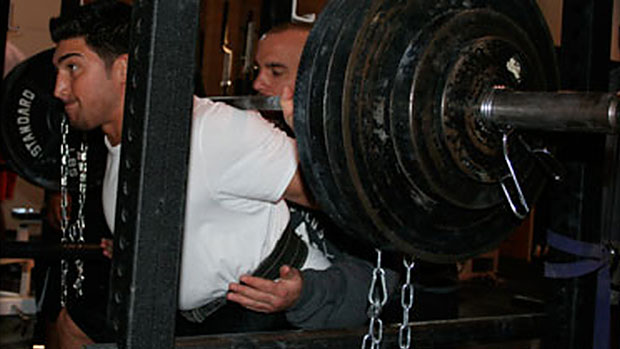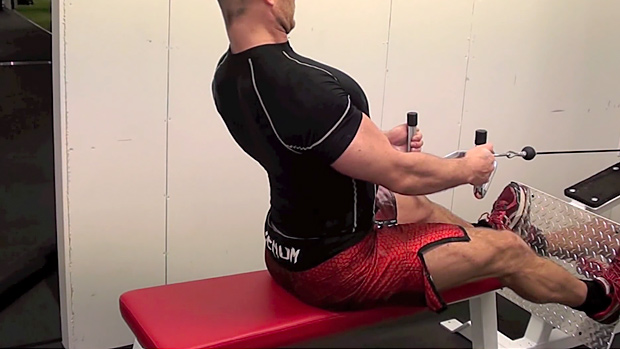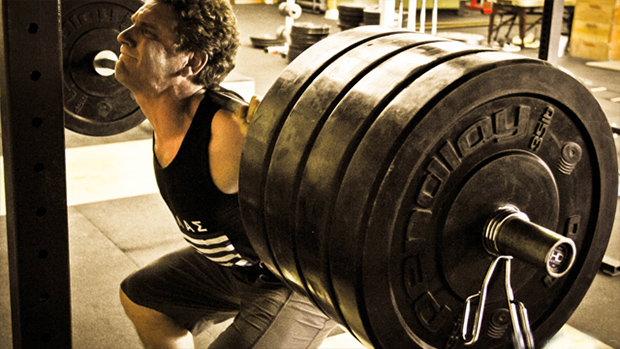Like most young lads with aspirations to be buff, I naively thought pro bodybuilders had all the secrets to getting swole. So, there I was, feverishly reading a shoulder training article written by one of the top pros at the time. One of the highpoints of the article was a superset for shoulders that he swore by. He'd go nonstop from dumbbell shoulder presses to lateral raises and then to front raises, all with the same set of dumbbells.
Now, although I was a greenstick at the time, I was savvy enough to notice that starting the superset by doing dumbbell presses with a weight light enough to allow you to do lateral and front raises would essentially be a waste of time. And I don't like to waste my training time and energy.
So, I reconstructed his messed up superset, putting the toughest exercise first and the easiest exercise last. I knew this would be better, but I still thought that if I stuck with the same set of dumbbells throughout, the dumbbell shoulder press would be too easy.
Off to the gym I went to put this new superset to the test.
"Holy crap!" was the first thing out of my mouth as I dropped the dumbbells from shoulder height after unsuccessfully trying to complete 15 reps of shoulder presses with those sissy-ass dumbbells. Though feeling like a pansy, I immediately knew I was on to something – and the Delt Triad was born.
Since then, the triad has been tested in the trenches for 15 years, and with great success. Clients love it because it's a perfect way to torch their delts in the shortest time possible. For that reason, it's perfect for days when you need to train shoulders but want to get in and out in a hurry.
More than the time efficiency benefit, people love it because the pump they get from the Delt Triad is insane! While a pump in and of itself doesn't necessarily mean results, more time under tension and a bit of fascial stretching damn sure doesn't hurt.
- A1. Lateral Raise: 3 x 12-15
- A2. Front Raise: 3 x 12-15
- A3. Overhead Dumbbell Press: 3 x 12-15
Rest about 90 seconds between each round (superset).
After doing a round of this triad, you'll notice that right after your shoulders stop feeling like they're on fire, you'll feel like all five liters of your blood is in your deltoids! But it doesn't stop there; you still have two more sets to go.
Don't worry; your effort won't be for naught. This triad works wonderfully for filling out your delts, making them nice and round. So, if you have visions of cannonball delts dancing around in your head, then you're in the right place – Santa has arrived.
In most instances, the ideal use of the Delt Triad is after you've done a compound movement with heavy weight and lower reps. Five sets of five reps of standing barbell shoulder presses would work perfectly. Then move on to the Delt Triad to finish off your delt workout with a good, fascia-stretching pump.
To get the most out of this triad, do the movements very precisely and without momentum. This will put the focus of each repetition squarely on the targeted muscle. Save the "move the weight" mentality for your compound, low-rep strength/power exercise. The name of the game with the delt triad is "mind-muscle connection."
If you think the mind-muscle connection is just some mental hooey popularized by an old school bodybuilder named Arnold, you're wrong. At least one study has shown that when participants focus on the working muscle, more motor units (and muscle fibers) are activated than when they focused on moving the weight. Hmm, maybe we bodybuilders aren't such dummies after all!
Speaking of the mind-muscle connection, when you get a few reps into the dumbbell presses and can't do anymore, throw the mind-muscle connection out the window and simply move the damn weight! You'll know what I mean when you get there.
Because precision is the name of the game, I would do the Delt Triad seated as opposed to standing. Although, occasionally doing it standing is perfectly valid. This will force you to use minimal torso swing, thereby maximizing the tension on your delts.
Speaking of precision, let's talk about how to precisely put the emphasis of the lateral raise squarely on the medial deltoid where it belongs.
Although you can start with the dumbbells in the neutral (palms facing) position, as soon as you initiate the movement, begin to pronate your hands, turning the thumb-side down and the pinky-side up. This causes internal rotation of the humerus and aligns the line of force (created by the dumbbell and gravity) with the line of pull (of the medial head of the deltoid).

Likewise, make sure that your shoulders, elbows, and wrists are all even and in the transverse plain at the top of the movement.
Now, let me address some common mistakes that you're likely to be making while doing the lateral raise.
Most people tend to let their elbows "sag," making it such that their hands reach the top position (level with the shoulders) before their elbows. This results in external rotation of the humerus and a shift of the resistance toward the anterior deltoid.
To correct this, first make sure that you're keeping the thumb-side down and pinky-side up. This makes it virtually impossible to do it wrong.
Another way to keep your elbows from drooping during the lateral raise is to think of leading with your elbows, not your hands. Pretend a vertical string is tied to the lateral aspect of your elbows and is pulling your elbows (and thus arms) up to the top position of the lateral raise.
Also make sure that your elbows are slightly flexed (bent). About 20 to 30 degrees of elbow flexion is perfect. This not only keeps you from locking your elbows, but it also puts you in just the right position to most comfortably execute perfect form.
Just make sure to not bend your elbows 90 degrees like some people do. Doing this simply shortens the lever arm of the resistance, allowing you to lift more weight, but without any more resistance on the deltoid itself.
You may think using more weight by being a sneaky, elbow-bending cheater would impress the ladies, but since you want a mate (or bed buddy) who reads T-Muscle, they'll be privy to your cheatin' ways and will actually be pointing and laughing at you.
Since you're now going to do lateral raises properly, be prepared to use about half the weight you were using. But if you left your ego at the door like you should, you'll appreciate properly stimulating your medial delts with a finely tuned lateral raise.
Properly targeting the anterior deltoid requires that we address both its primary and secondary function. While many people know that the anterior deltoid raises the arm to the front (called shoulder flexion), most overlook the fact that it also works to internally rotate the shoulder joint.
To perfectly stimulate the anterior delt during the front raise portion of the triad, we're going utilize both shoulder flexion and internal rotation. This results in a maximal contraction – a peak contraction as we bodybuilders call it.
Start the movement seated and with a neutral grip, palms facing one another. Raise the dumbbells up toward the front. As they clear your legs, begin to internally rotate at the shoulder, turning your palms down.
To elicit a full contraction, continue to internally rotate until the thumb side of the dumbbell is a bit lower than the pinky side. (Note that in the finish position photo below, this extra bit of internal rotation isn't shown.)
If you find that this much internal rotation causes a bit of pain in your shoulder, then don't do it. And by the way, you probably have impingement syndrome or bicipital tendonitis.
Unlike the lateral raise which has its ending position such that your arms are parallel to the ground, the front raise should end with your shoulder slightly above parallel (about 110 degrees of shoulder flexion). In case you forget to take your protractor to the gym, just raise the dumbbells until they're level with the top of your eyes.


By the time you get to these, your shoulders will feel like they're catching fire from the inside out. And for some reason, that makes it hard to focus on pinpoint precise form. No worries, there's really not much you can do wrong on dumbbell shoulder presses.
Do try to keep your forearms vertical with your elbows under your wrists. Though this may feel a tad awkward at first (as if your elbows are too far forward), it's best because it allows maximum force output.


Although you should normally go down until the dumbbell grip is about mouth or chin level and up just short of lockout, you'll probably find that doing this on the final few reps is about as hard as not committing a sin in Vegas. But instead of stopping, finish out the set with partials if you need to.
If you're doing a compound movement first in your shoulder routine as I generally recommend, you may not need a warm-up set on the Delt Triad. But when in doubt, do a light warm-up.
With the exception of that possible warm-up, your delts should be burning so badly at the end of the dumbbell press set that you want to throw those damned dumbbells down and shake out your shoulders while mumbling phrases that rhyme with "mother trucker" or "holy ship."
I tend to train rear delts with back because, functionally, it makes more sense. So, here's an example of a shoulder routine using the Delt Triad:
- A. Standing barbell shoulder press: 5 x 5
- B1. Seated lateral raises: 3 x 12-15
- B2. Seated front raises: 3 x 12-15
- B3. Seated dumbbell shoulder press: 3 x 12-15
- C. Shoulder stretches: (horizontal adduction and horizontal abduction) 2 x 20 seconds each


Bombs Away
Until next time, train hard, eat right, and enjoy turning those delts into cannonballs!





